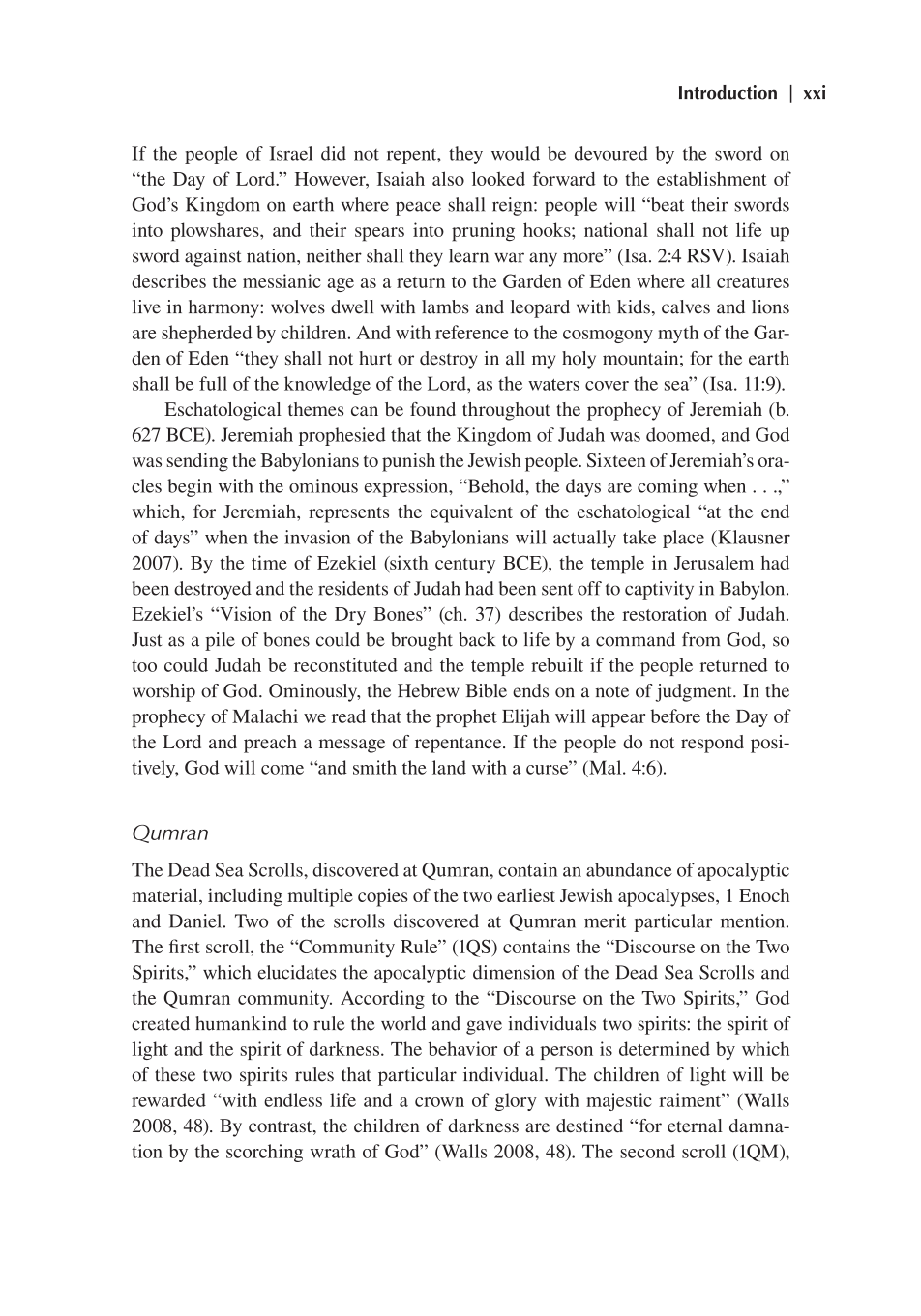xxi | Introduction
If the people of Israel did not repent, they would be devoured by the sword on
“the Day of Lord.” However, Isaiah also looked forward to the establishment of
God’s Kingdom on earth where peace shall reign: people will “beat their swords
into plowshares, and their spears into pruning hooks; national shall not life up
sword against nation, neither shall they learn war any more” (Isa. 2:4 RSV). Isaiah
describes the messianic age as a return to the Garden of Eden where all creatures
live in harmony: wolves dwell with lambs and leopard with kids, calves and lions
are shepherded by children. And with reference to the cosmogony myth of the Gar-
den of Eden “they shall not hurt or destroy in all my holy mountain; for the earth
shall be full of the knowledge of the Lord, as the waters cover the sea” (Isa. 11:9).
Eschatological themes can be found throughout the prophecy of Jeremiah (b.
627 BCE). Jeremiah prophesied that the Kingdom of Judah was doomed, and God
was sending the Babylonians to punish the Jewish people. Sixteen of Jeremiah’s ora-
cles begin with the ominous expression, “Behold, the days are coming when . . .,”
which, for Jeremiah, represents the equivalent of the eschatological “at the end
of days” when the invasion of the Babylonians will actually take place (Klausner
2007). By the time of Ezekiel (sixth century BCE), the temple in Jerusalem had
been destroyed and the residents of Judah had been sent off to captivity in Babylon.
Ezekiel’s “Vision of the Dry Bones” (ch. 37) describes the restoration of Judah.
Just as a pile of bones could be brought back to life by a command from God, so
too could Judah be reconstituted and the temple rebuilt if the people returned to
worship of God. Ominously, the Hebrew Bible ends on a note of judgment. In the
prophecy of Malachi we read that the prophet Elijah will appear before the Day of
the Lord and preach a message of repentance. If the people do not respond posi-
tively, God will come “and smith the land with a curse” (Mal. 4:6).
Qumran
The Dead Sea Scrolls, discovered at Qumran, contain an abundance of apocalyptic
material, including multiple copies of the two earliest Jewish apocalypses, 1 Enoch
and Daniel. Two of the scrolls discovered at Qumran merit particular mention.
The first scroll, the “Community Rule” (1QS) contains the “Discourse on the Two
Spirits,” which elucidates the apocalyptic dimension of the Dead Sea Scrolls and
the Qumran community. According to the “Discourse on the Two Spirits,” God
created humankind to rule the world and gave individuals two spirits: the spirit of
light and the spirit of darkness. The behavior of a person is determined by which
of these two spirits rules that particular individual. The children of light will be
rewarded “with endless life and a crown of glory with majestic raiment” (Walls
2008, 48). By contrast, the children of darkness are destined “for eternal damna-
tion by the scorching wrath of God” (Walls 2008, 48). The second scroll (1QM),


























































































































































































































































































































































































































